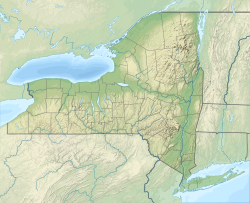Agudas Achim straddles the entire era of Jews in the Catskills. Founded by a religious and ethnically diverse community, it became Orthodox by default, although not all its members were. Along with the Sullivan County resort industry, it went into a slow decline after World War II when other vacation opportunities opened up to the region's primarily Jewish clientele. A change to a formal affiliation with Reform Judaism has reversed the decline of both the building and its congregation. New residents in the area often have second or retirement homes there.
1882–1972: Rise and decline
Jewish settlement in the Livingston Manor area began in 1882 when what was then known as the New York and Oswego Midland Railroad built a depot there. Local farmers could ship their produce to New York City. Some German Jews who had emigrated to the United States found their way to the Catskills and developed dairy farms. The railroad provided access to the region for city residents who wanted to get away from the summer heat, leading some farmers and residents to get into the resort and summer camp business. Many resort facilities discriminated against Jews, refusing them as guests. [1]
In 1900, with the arrival of a new wave of Jews from Eastern Europe, new resorts were developed that catered specifically to Jewish guests. The first Jewish family settled in Livingston Manor in 1906; the first Jewish resort opened two years later. In those early years antisemitism was overt, with local residents regularly referring to the Jews as "kikes". The first recorded action of the Jewish community in the hamlet was in 1912, when several families banded together to buy land for a cemetery. Local Christian graveyards would not accept Jews. [1]
By the 1920s, Jews made up 10% of the local population and played a larger role in local public life, lessening the hostility. Local members of The Workmen's Circle (known at the time by its Yiddish name, the Arbeiterring) started a school for Jewish children. It had four classes and was used to host social events and some religious services. Jewish identity was often expressed primarily through cultural events. [1]
Beginning in that decade, newer Jewish arrivals in Livingston Manor were as committed to Judaism as a faith as well as a culture. These immigrants began holding High Holy Days services at a rented pavilion on the shores of Willowemoc Creek, now the site of Livingston Manor High School. In 1922, the more religious Jews gained the upper hand in the community following the departure of some of the Arbeittering members, and incorporated the congregation of Agudas Achim. They bought land and Izzy Brooks, one of the few practicing Orthodox Jews in town, built the synagogue. It was opened two years later in 1924. [1]
More secular Jews also supported the synagogue, and eventually the school founded by the Arbeiterring closed down. The synagogue observed traditional rites and came to be considered Orthodox although it was never formally affiliated with any broader Orthodox Jewish group. Farmers and hotel owners in the congregation, many of whom lived a long distance from the town, would often drive in for Shabbat services, park a discreet distance from the synagogue and walk from there to services to maintain the appearance of following Jewish law against driving (considered work). [1]
The Jews of Livingston Manor and their synagogue prospered during the Depression due to a summer influx of middle-class garment workers from the city. Newly unionized, the workers could afford summer vacations at Jewish mountain resorts. Among the Rabbis who served the congregation during this time were Rabbi Meir Bilitsky, ordained at Yeshiva Chaim Berlin, who began his rabbinical career in this synagogue, later moving to New Hyde Park, where he served as rabbi for the rest of his life. This increasing affluence turned against the Catskills in the 1950s. These same Jews and their descendants moved into suburban homes and began to vacation elsewhere, including those resorts that had once been closed to them. Jews began to leave the village, and by 1972 Agudas Achim was open only during the High Holy Days and beginning to deteriorate. [1]
As the congregation had dwindled to 35 members, its board began to explore formally becoming a Conservative or Reform synagogue. In 1981 it began hiring Reform rabbis, including women, to conduct services. Several years later, newer members joined with some of the older ones to form a revitalization committee. In 1984, after several older members had retired to Florida, the congregation formally became Reform. [4] The congregation president at the time, Leon Siegel, invested Ladies' Aid Society funds from the 1960s to create an endowment that helped pay for repair and maintenance of the building. [1]
In 1990 the synagogue hired a regular rabbi and began holding services once a month. [1] Two years later it celebrated its first bar mitzvah since 1971. [5] By 1999 the congregation had grown to 105 families, possibly its largest membership ever. [4]
It now holds monthly services year-round, even though some of Livingston Manor's Jews spend the winter in Florida. It also operates a Hebrew school. [4] In 2008 five of its students celebrated their bar or bat mitzvahs, a large number for a small congregation. [5] It is a member synagogue of the Union for Reform Judaism. [6]



